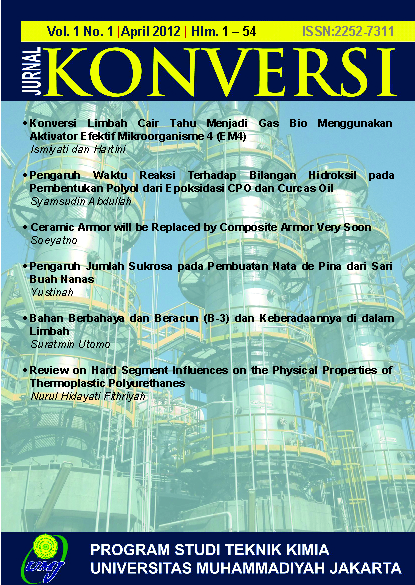REVIEW ON HARD SEGMENT INFLUENCESON THE PHYSICALPROPERTIES OF THERMOPLASTICPOLYURETHANES
Main Article Content
Abstract
Thermoplastic polyurethanes (TPUs) are the fastest growing market in polyurethane technology mainly due to their easy process ability, versatile properties and recyclable nature. They find applications in high performance materials like coatings, adhesives, fibres and foams in a variety of industries ranging from automotive and footwear to medical implants. TPUs are linear block copolymers comprising of alternating soft and hard segments. The versatile properties of TPUs are usually attributed to their phase-separated morphologies. Different parameters are known to affect TPUs physical properties. One of those is their chemical architecture that is the statistical arrangement of hard segments (HS) and soft segments (SS).In particular the architecture of the HS will influence the molecular structure and intermolecular interaction. Its role as physical crosslink sites will govern thermal, mechanical and morphological properties. Hence a modification of HS chemical architecture might adjust the ultimate properties of TPU. This implication is important in process control of production and design of application. Therefore this paper will review various studies to understand the effect of different architecture to the properties of TPU. Keywords: thermoplasticpolyurethanes, hard segment architecture, physical properties
Article Details
Issue
Section
Articles
Authors who publish with this journal agree to the following terms:
- Authors retain copyright and grant the journal right of first publication with the work simultaneously licensed under a Creative Commons Attribution License that allows others to share the work with an acknowledgement of the work's authorship and initial publication in this journal.
- Authors are able to enter into separate, additional contractual arrangements for the non-exclusive distribution of the journal's published version of the work (e.g., post it to an institutional repository or publish it in a book), with an acknowledgement of its initial publication in this journal.
- Authors are permitted and encouraged to post their work online (e.g., in institutional repositories or on their website) prior to and during the submission process, as it can lead to productive exchanges, as well as earlier and greater citation of published work (See The Effect of Open Access).
